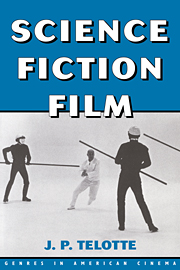Book contents
- Frontmatter
- Contents
- List of Illustrations
- Acknowledgments
- PART I APPROACHES
- PART II HISTORICAL OVERVIEW
- PART III FILM ANALYSES
- 4 The Science Fiction Film as Fantastic Text: THX 1138
- 5 The Science Fiction Film as Marvelous Text: Close Encounters of the Third Kind
- 6 The Science Fiction Film as Uncanny Text: RoboCop
- 7 Crossing Genre Boundaries/Bound by Fantasy: The Fly (1986)
- 8 Conclusion: A Note on Boundaries
- Notes
- Bibliography
- Select Filmography of the American Science Fiction Film
- Index
7 - Crossing Genre Boundaries/Bound by Fantasy: The Fly (1986)
Published online by Cambridge University Press: 03 December 2009
- Frontmatter
- Contents
- List of Illustrations
- Acknowledgments
- PART I APPROACHES
- PART II HISTORICAL OVERVIEW
- PART III FILM ANALYSES
- 4 The Science Fiction Film as Fantastic Text: THX 1138
- 5 The Science Fiction Film as Marvelous Text: Close Encounters of the Third Kind
- 6 The Science Fiction Film as Uncanny Text: RoboCop
- 7 Crossing Genre Boundaries/Bound by Fantasy: The Fly (1986)
- 8 Conclusion: A Note on Boundaries
- Notes
- Bibliography
- Select Filmography of the American Science Fiction Film
- Index
Summary
Throughout this overview of the science fiction film we have been using a pointedly discriminatory approach in order to sort out what for many seems a rather amorphous and unwieldy genre. That is, we have turned to contemporary discussions of fantasy and employed those discrete distinctions made by Todorov between the marvelous, fantastic, and uncanny varieties of fantasy in order to help distinguish some of the primary narrative types of science fiction film and to account for some of the genre's appeal. However, the fact remains that all of these films occupy some fairly problematic generic ground, a point often evident in critical commentary on them. In his early but still useful history of the horror film, Carlos Clarens, like a number of others, simply treated science fiction as part of the cinematic territory. Working from an affective approach to genre, that is, considering it in terms of how it primarily affected viewers, he saw science fiction as just another variation of a form usually aimed at producing a sense of shock, fear, or surprise in its audience. Similarly focusing on effects, Bruce Kawin too has described how hard it is for most of us to draw reliable boundaries between horror and science fiction, even as he suggests that trying to do so can serve us “in the interest of working toward a definition” of either genre.
- Type
- Chapter
- Information
- Science Fiction Film , pp. 179 - 196Publisher: Cambridge University PressPrint publication year: 2001

